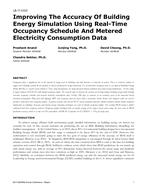Description
Occupancy plays a significant role in the amount of energy used in buildings and their presence is stochastic in nature. There is extensive evidence to suggest that buildings usually do not perform as well as predicted by energy simulation. Use of unrealistic occupancy data as an input of Building Energy Model (BEM) is a major reason behind it. Thus, large discrepancies are being observed between predicted and actual energy performance. In this study, it ranges between 29.8-43.2% with default occupancy input. The research aims to increase the accuracy of existing campus building energy model through real-time occupancy schedule and metered electricity consumption data. Firstly, 180 days (a semester in an academic year) of the measured hourly electricity consumption (Plug load and lighting) kWh and occupancy data for spaces like a classroom, lecture theater and computer room are used to develop a daily floor wise occupancy profile. A generic, feasible and low-cost Wi-Fi based occupancy detection solution provides reliable hourly occupancy information in buildings. K-means and hourly average clustering techniques are used to identify occupancy profile. The existing BEM model is further calibrated with this occupancy pattern. Occupancy profile developed with an hourly average of the largest cluster mean shows the least error in BEM prediction accuracy, which is as low as 6.9% and within ASHRAE Guideline 14 (CVRMSE < 15%) for daily data.
Citation: 2017 Annual Conference, Long Beach, CA, Conference Papers
Product Details
- Published:
- 2017
- Number of Pages:
- 8
- Units of Measure:
- Dual
- File Size:
- 1 file , 1.9 MB
- Product Code(s):
- D-LB-17-C033




